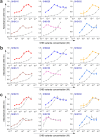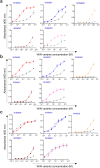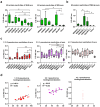Non-cognate ligands of hepatitis C virus envelope broadly neutralizing antibodies induce virus-neutralizing sera in mice
- PMID: 40766312
- PMCID: PMC12321816
- DOI: 10.3389/fimmu.2025.1624299
Non-cognate ligands of hepatitis C virus envelope broadly neutralizing antibodies induce virus-neutralizing sera in mice
Abstract
Introduction: The persistent rise in new Hepatitis C virus (HCV) infections threatens WHO efforts to eliminate HCV infection by 2030. Although direct-acting antiviral (DAA) drugs are efficacious, access remains limited, reinfections occur, and perinatal infections continue to pose long-term complications. Therefore, an effective anti-HCV vaccine is urgently needed.
Methods: We employed a highly complex combinatorial Myomedin-loop scaffold library to identify variants binding to paratopes of HCV E2-specific broadly neutralizing antibodies (bNAbs) HC-1AM and HC84.26.WH.5DL. The selected binders, named SHB and WIN, respectively, represent non-cognate mimotopes of the aforementioned bNAbs. These binders were subsequently used as immunogens in experimental mice to elicit serum antibodies capable of binding to HCV E2 and neutralize HCV pseudotyped viruses.
Results and discussion: The non-cognate mimotopes SHB and WIN competed with the E2 glycoprotein for bNAbs binding and, after immunizing experimental mice, elicited E2- and HCV-pseudovirus-specific antibodies. WIN- and SHB-immunized mice exhibited neutralization against 15 HCV pseudoviruses with varying neutralization sensitivities. The most potent binders WIN028 and WIN047, were modified with a C-terminal His-tag, allowing the generation of WIN proteoliposome and subsequent use in experimental mice immunizations. Hyperimmune sera exhibited improved binding to HCV E2 and neutralized 60% of the tested HCV pseudoviruses. The broad neutralization of HCV pseudoviruses achieved by hypperimmune sera from SHB- and WIN-immunized mice highlights the potential of this approach in the HCV vaccine design.
Keywords: broadly neutralizing antibodies; hepatitis C; mimotope; myomedins; protein mimicry; protein scaffolds; vaccine.
Copyright © 2025 Walimbwa, Bharadwaj, Kosztyu, Vankova, Kuchar, Kopecna, Effenberg, Drasar, Raskova Kafkova, Maly and Raska.
Conflict of interest statement
The authors declare that the research was conducted in the absence of any commercial or financial relationships that could be construed as a potential conflict of interest.
Figures








Similar articles
-
Virus-Like Particles Containing the E2 Core Domain of Hepatitis C Virus Generate Broadly Neutralizing Antibodies in Guinea Pigs.J Virol. 2022 Mar 9;96(5):e0167521. doi: 10.1128/JVI.01675-21. Epub 2022 Jan 5. J Virol. 2022. PMID: 34986001 Free PMC article.
-
A Recombinant Hepatitis C Virus Genotype 1a E1/E2 Envelope Glycoprotein Vaccine Elicits Antibodies That Differentially Neutralize Closely Related 2a Strains through Interactions of the N-Terminal Hypervariable Region 1 of E2 with Scavenger Receptor B1.J Virol. 2019 Oct 29;93(22):e00810-19. doi: 10.1128/JVI.00810-19. Print 2019 Nov 15. J Virol. 2019. PMID: 31462563 Free PMC article.
-
Epitope-focused immunogens targeting the hepatitis C virus glycoproteins induce broadly neutralizing antibodies.Sci Adv. 2024 Dec 6;10(49):eado2600. doi: 10.1126/sciadv.ado2600. Epub 2024 Dec 6. Sci Adv. 2024. PMID: 39642219 Free PMC article.
-
NIH Consensus Statement on Management of Hepatitis C: 2002.NIH Consens State Sci Statements. 2002 Jun 10-12;19(3):1-46. NIH Consens State Sci Statements. 2002. PMID: 14768714
-
Pharmacological interventions for acute hepatitis C infection: an attempted network meta-analysis.Cochrane Database Syst Rev. 2017 Mar 13;3(3):CD011644. doi: 10.1002/14651858.CD011644.pub2. Cochrane Database Syst Rev. 2017. Update in: Cochrane Database Syst Rev. 2018 Dec 03;12:CD011644. doi: 10.1002/14651858.CD011644.pub3. PMID: 28285495 Free PMC article. Updated.
References
MeSH terms
Substances
LinkOut - more resources
Full Text Sources
Medical
Miscellaneous

